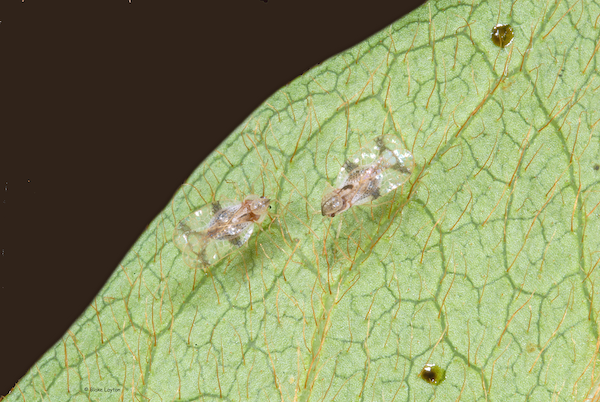Azalea Lace Bugs, Vol. 7, No. 6
Related News
April 11, 2013
April 2, 2013
March 14, 2013
February 28, 2013

Heavy, damaging infestations of lace bugs are most likely to occur on azaleas growing in full sun or on plants that are stressed by drought or other factors. Also, some varieties are more susceptible than others. Once plants are severely damaged, it can take some time for them to recover.
Avoid excessive lace bug damage to azaleas in your landscape by regularly checking the undersides of leaves for adults or nymphs. You won’t be able to find lace bugs through the winter months because they overwinter as eggs inserted into the leaf tissue, but the brown fecal spots left from the previous growing season will remain on the undersides of leaves as a sign of infestation. Begin scouting in early spring and consider treating if you start finding significant numbers of lace bugs and damage symptoms. Also, some plantings have a history of recurring lace bug infestations, and these are candidates for early preventive treatments. Soil-applied systemic insecticides usually provide season-long control. Although somewhat costly, these are a good choice for treating plantings that routinely suffer heavy attack.
Control: For fast-acting control of heavy lace bug infestations spray with a foliar-applied systemic insecticide such as acephate (Orthene Tree, Turf and Ornamental 97 Spray) or imidacloprid (Bonide Annual Tree and Shrub Insect Control Concentrate). For long-lasting preventive control use a soil-applied systemic treatment such as imidacloprid (Fertilome Tree and Shrub Drench, Bonide Annual Tree and Shrub Insect Control Concentrate, and Monterey Once a Year Insect Control II are examples.). For best control of severe infestations do both; spray with acephate and apply a soil treatment of imidacloprid. Be sure to follow label precautions for protecting pollinators.
See Extension Publication 2369, Insect Pests of Ornamental Plants in the Home Landscape, page 17-18 and pages 38-40 for more information. http://extension.msstate.edu/sites/default/files/publications/publications/p2369.pdf
Blake Layton, Extension Entomology Specialist, Mississippi State University Extension Service.
The information given here is for educational purposes only. Always read and follow current label directions. Specific commercial products are mentioned as examples only and reference to specific products or trade names is made with the understanding that no discrimination is intended to other products that may also be suitable and appropriately labeled.
Mississippi State University is an equal opportunity institution.
Bug’s Eye View is now on Facebook. Join the Bug's Eye View Facebook group here.